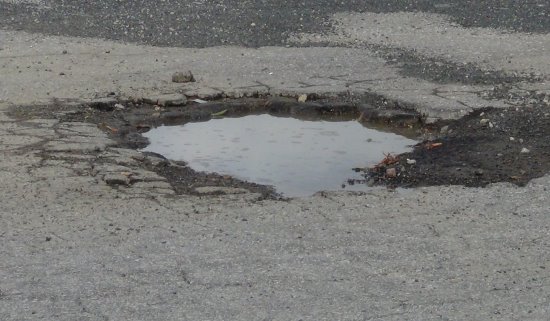Until the road can heal itself, pot holes are going to be ever present, with council contractors always one step behind when it comes to fixing them. They damage tyres and wheels, and are even more dangerous for cyclists and motorcyclists who can be thrown from their machines. But how do we get pot holes and why haven’t we figured out a way of stopping them from forming.

Water and gravity are the enemy of a road, and with our increasing torrential downpours, pot holes are going to form more quickly than before.
First, the road’s surface is slightly porous due to cracks that form when vehicles drive over it, and because of the heating and cooling of the surface. Water drains through the cracks and gets into the road’s substrate where it washes away smaller particles and compresses the larger ones. This causes the road to have a small depression whereby the road’s surface flexes. More water flows in, further weakening around the edge of the depression and causing deeper cracks.
If the area is prone to frosts, the water just below the surface can freeze, causing expansion which further breaks up the surface causing small blocks or ‘alligator cracking’ to form. Eventually, one of these blocks is dislodged by a vehicle’s tyre.
Now the pot hole can start its rapid growth phase. With exposed edges, other blocks are compromised – they can move more laterally – and will be ejected from the road. Rain accelerates the process by washing away some of the substrate and filling up the pot hole.
When the pot hole gets big enough, the substrate will start to wear away, too, and a deeper pot hole will form.
The council will fix it either when someone notifies them of it, or when it’s reported by one of their roving team.
Why are roads so weak? There’s a meme implying that Roman roads were built really strongly and lasted centuries and we should build them like that now.

This is rubbish. Roman roads did not have to endure 50-tonne trucks and thousands of 2-tonne vehicles a day. They handled foot traffic and the odd cart. They were also anything but smooth, which you’ll know if you’ve ever tried walking on or driving on any of the remaining ones in Italy, such as Via Appia!

Today, road construction has to take into consideration factors like budget and overall disruption to traffic. You can engineer a road to be very strong, but it would be prohibitively expensive; roads are already expensive as it is.
Other factors are:
Utilities and utility maintenance: buried pipes and manhole covers form areas of weakness in the road. The edges of a manhole cover, where it intersects with the tarmac, take a battering. Induction loops at traffic lights are weak areas.

Trenches cut into the road to repair pipes and cables also form weak spots as the trench will be differently compacted to the surrounding road.
Maintenance: poor quality seal repairs fail quickly. Cracks form and the pot hole process starts again.

Verges: where tarmac meets grass, the grass attempts to put down roots into the tarmac. These edges are invariably weaker, too, as they are not considered to be the main carriageway. Cracks that start at the edge can spread to the carriageway.
Drainage: roads usually are sloped towards their edge so that water drains there. However, vehicles eventually wear ruts into the road through compaction and wear on the surface. Water begins to collect in these ruts where vehicles passing over it forces it into cracks.

